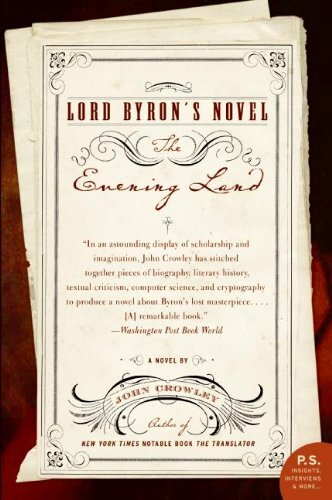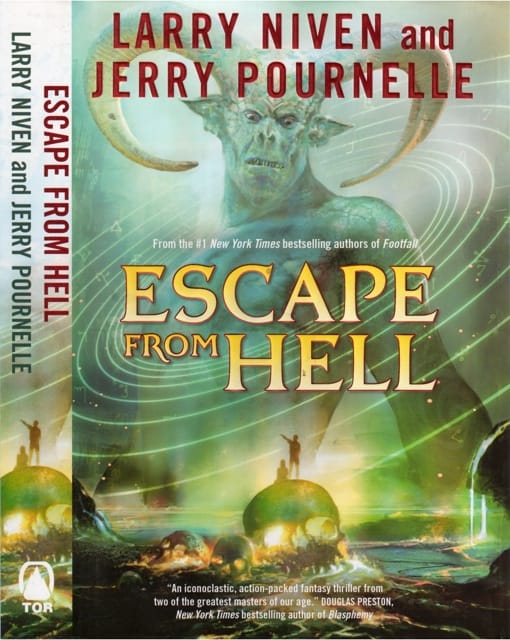The Long View: Lord Byron's Novel by John Crowley
Sometimes when John reviews a book, it is just a book, and not part of his grander projects. Lord Byron’s Novel: Evening Land [Amazon link] by John Crowley is an interesting example of how in some ways, everything that #MeToo movement talked about was out in the open, if you cared to look.

Lord Byron’s Novel: The Evening Land
By John Crowley
William Morrow, 2005 465 Pages, US$25.95
ISBN 0-06-055658-7
The Devil’s Dictionary (the one by Ambrose Bierce) defines “Posterity” as “An appellate court which reverses the judgment of a popular author’s contemporaries, the appellate being his obscure competitor.” In this book, Posterity does not intervene to move an obscure author to a higher niche in the temple of fame (we’re dealing with Lord Byron), but to render his reputation less damning. This feat is accomplished through a literary discovery that occasions, in the 21st century, the reconciliation between a daughter and a father that Byron allegedly desired with his own family but never achieved. What we have here is the future as an afterlife, where old sins are revealed and forgiven.
There are three layers in this book: a make-believe novel (a novella, really) by Lord Byron; an equally fictional collection of notes on that text, by Ada, his daughter; and an epistolary novel, composed chiefly of emails exchanged among the discoverers and editors of these supposed new texts. The hook for the premise was not far to seek. We all recall that, just after the Napoleonic wars, Byron was in Switzerland with the Shelleys at that house party that produced both “Frankenstein” and the first vampire novel. On that occasion, Byron is reputed to have started a Gothic story of his own, but to have abandoned the project. Well, maybe not. In any case, the Byron text starts so:
“Observe—But no! No one may observe, save the unfeeling Moon, who sails without progress through the clouds—a young Lord, who on the ramparts of his half-ruined habitation keeps a late watch…”
Fortunately, it soon gets faster and funnier, turning in part into a society novel about marriage and reputation, with some anthropological excursions into the clans of Albania and into the Venetian aristocracy. The tale deals with the life of Ali, the illegitimate son of Lord (“Satan”) Sane. That ogre takes the trouble to retrieve his bastard in order to secure his wife’s life estates, which would revert to other claimants at the time of her death if he did not have an heir. Byron’s own father’s nickname was “Mad Jack,” and though he did not live long enough to participate in Byron’s upbringing, one of the ways in which Ali’s life mirrors Byron’s is that both grew up under the suspicion that they would turn out “mad, bad, and dangerous to know.” The chief parallel, though, is that each married a blameless but rather inflexible woman. A daughter is born, but husband and wife are soon separated. Lady Byron long outlived her husband and, at least in this telling, blackened his name with Christian evangelical venom. Byron’s novel is essentially a long letter of explanation to his daughter.
Ada Byron (1815-1852), Countess of Lovelace, was a friend of Charles Babbage, the designer of the Difference Engine. That device is widely regarded as the forerunner of the computer. Ada was a mathematician and cryptographer in her own right; we are told here that one of her letters to Babbage contained what, in effect, was the first computer program. The original text of the Byron novel is destroyed by the implacable Lady Byron (did I mention that she was a Christian?), but not before Ada had encrypted it as sheets of numbers, which she keeps among her papers as mathematical work of no interest to her prying mother. The text would have been too cumbersome to decrypt in the 19th century, but Ada was prescient: she knew that someday truly programmable engines of the sort envisioned by Babbage will be able to reconstruct the novel.
Meanwhile, in the early 21st century (type is more important than sequence in this sort of fiction), a group of female historians and programmers is organizing a website about women in the history of science. Some of the organizers are lesbians of the strict observance, among them Alexandra (“Smith”) Novak. She scarcely remembers her disgraced but internationally renowned father. This has a familiar ring. Byron left England for personal reasons, but much of his reputation rests on his later involvement with revolutionary nationalism. (Ali in the novel becomes a member of an international network called “the Lucifers,” who bear some resemblance to the Carbonari.) Similarly, Lee Novak has for many years been making critically acclaimed documentaries about the poor and oppressed around the world. He cannot film the poor and oppressed in the United States, however: a warrant for his arrest is still out in connection with an incident of low-down turpitude involving an underage girl at a Hollywood party.
Smith was very young when her father fled. Her mother, egged on by her circle of feminist supporters, prevented his attempts to contact her, in rather the way that the evangelicals around Lady Byron stoked her sense of grievance. Nonetheless, or maybe for that reason, Ada might well have sought out her father had he lived longer. Rather more conveniently, Smith’s father is not only alive, but a former university professor and a leading expert on Byron.
The interesting thing about the reconciliation between father and daughter is that father is simply guilty. He makes no excuses, and he does not defend himself, though he expands on the temptations to which even a documentary filmmaker is subject. Smith comes to understand his crime only to the extent that she finally knows exactly what happened. Then she just forgives him. Pure forgiveness is always startling in fiction, because it makes no narrative sense. We accept it only because it happens in real life all the time. Still, Lee’s account also suggests that a more sympathetic assessment of Byron’s personal life may be in order. He was the Regency equivalent of a rock star, but he wasn’t a nihilist; and even if his protestations of remorse sometimes smack of melodramatic self-promotion, even Byron thought that Byron was something of a cartoon. Part of the problem with his marriage may have been that, when he was being self-deprecating, Lady Byron thought he was just telling the truth.
This is a fine novel. Certainly the author is to be congratulated for making all these people from different centuries sound different, down to the email writer who distains punctuation. Still, John Crowley’s fans may not find just what they usually expect from him. There are, perhaps, subtle supernatural elements in this book. However, they should not be confused with the Gothic trappings that figure so prominently in the Byron text, Gothic being a form that favors either materialism or frank fantasy. Even the one zombie is probably a natural phenomenon, says Ada Byron, and Ada is always right.
Copyright © 2005 by John J. Reilly
Support the Long View re-posting project by downloading Brave browser, and then trying it out. With Both Hands is a verified Brave publisher, you can leave me a tip too!



Comments ()